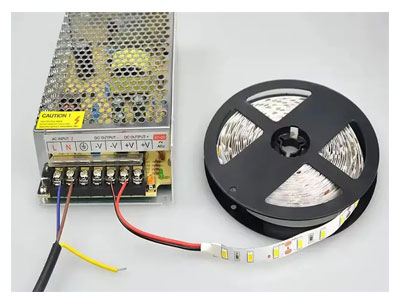Key Takeaway
To connect LED strip lights to a power supply, first, identify the input and output terminals on the power supply. Connect the input terminals to the mains power: blue for neutral, brown for live, and green/yellow for earth. Next, connect the output terminals to the LED strip lights: black for negative and red for positive. Ensure all connections are secure and insulated. Finally, plug in the power supply and switch on the LED lights to check the connection.
Required Materials and Tools
To connect LED strip lights to a power supply, you’ll need a few essential materials and tools. First, ensure you have the LED strip lights, a compatible power supply, and appropriate connectors. You’ll also need wire cutters, a soldering iron (if soldering is required), and electrical tape. A voltage tester can be handy to verify connections. Having the right tools and materials ensures a smooth and safe installation process, preventing potential issues that could arise from using incorrect or substandard equipment.

Safety Considerations
Safety is paramount when working with electrical components, especially in an industrial setting. Always ensure the power supply is unplugged before beginning any work. This simple step can prevent serious injuries. Wearing insulated gloves and using tools with insulated handles are essential practices to avoid electric shocks. Double-checking the voltage rating of your LED strips and power supply is another critical measure. Ensuring they match prevents damage to the LED strips and mitigates safety risks.
Working in a well-lit area is essential for visibility, and maintaining a dry workspace is crucial to avoid any electrical accidents. Additionally, it is important to avoid working alone. Having a colleague nearby can be beneficial in case of emergencies. Understanding and adhering to these safety measures can prevent injuries and ensure a smooth and successful installation. Safety should never be compromised, and these steps are fundamental to creating a safe working environment. By incorporating these practices into your routine, you can ensure not only your safety but also the efficiency and longevity of the LED strips. Remember, safety first ensures a trouble-free project execution.
Step-by-Step Connection Guide
Connecting LED strip lights to a power supply is a straightforward process, but attention to detail is vital. Begin by measuring the required length of the LED strip and cutting it precisely at the marked cut points. If connectors are not pre-installed, strip the insulation off the wire ends carefully. Connect the positive wire from the LED strip to the positive terminal of the power supply and the negative wire to the negative terminal. Secure the connections firmly with solder or appropriate connectors to ensure stability.
Once the connections are made, plug in the power supply and test the LED strip lights. Make any necessary adjustments to ensure even illumination and secure connections. This methodical approach ensures that the LED strips function correctly and safely. Following these steps meticulously can prevent common issues such as flickering or uneven lighting, ensuring a professional and reliable installation. Proper connection techniques are essential for maintaining the performance and safety of your LED strip lights. By following this step-by-step guide, you ensure a successful and efficient setup.
Common Mistakes to Avoid
Avoiding common mistakes when working with LED strips can save significant time and prevent damage. One frequent error is using an incompatible power supply. This mismatch can lead to overheating or complete failure of the LED strips. Always ensure the power supply matches the voltage and current requirements of the LED strips. Another common mistake is not securing the connections properly. Loose connections can result in flickering lights or intermittent functioning. Double-check all connections and use appropriate connectors or soldering techniques to ensure stability.
Overloading the power supply by connecting too many LED strips is another mistake to avoid. This can cause the power supply to fail and potentially damage the LED strips. Additionally, avoid bending the LED strips too sharply, as this can damage the circuitry. By paying close attention to these details and avoiding these common pitfalls, you can ensure a smooth and successful installation process. Proper planning and execution are key to achieving optimal performance and longevity of your LED strip lights. Awareness of these mistakes helps in preventing future issues.
Ensuring Optimal Performance
Ensuring the optimal performance of your LED strip lights requires adherence to a few key practices. Using a power supply that matches the LED strip’s voltage and current requirements is crucial. This prevents issues such as overheating and ensures efficient operation. Adequate ventilation for the LED strips is essential to prevent overheating, which can significantly reduce their lifespan. Ensuring secure connections using connectors or solder joints helps avoid voltage drops and maintains consistent performance.
Regularly checking the connections and power supply for any signs of wear or damage is also important. Early detection of issues can prevent major problems and prolong the life of your LED strips. Avoid placing the LED strips in locations where they are exposed to moisture or extreme temperatures, as these conditions can affect performance. By following these practices, you can maintain the efficiency and longevity of your LED strip lights, ensuring they provide consistent illumination for your projects. Maintaining optimal performance not only enhances the quality of your work but also contributes to safety and reliability in industrial applications.
Conclusion
Connecting LED strip lights to a power supply is a simple process with the right materials, tools, and safety precautions. By following a step-by-step guide, avoiding common mistakes, and ensuring optimal performance, you can achieve professional and long-lasting results. Remember to prioritize safety, use compatible components, and secure connections for the best outcomes. With these tips, even a newly joined engineer in the industry can confidently handle LED strip light installations.
